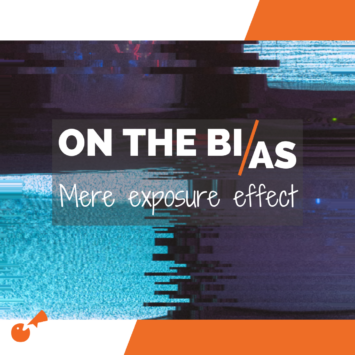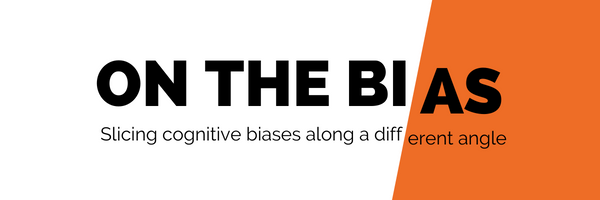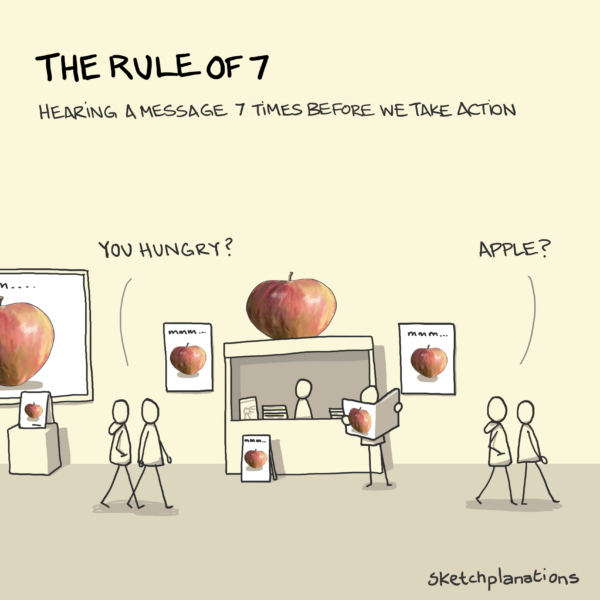
ON THE BIAS: Mere Exposure Effect
Welcome to the blog series, ON THE BIAS.
In this series, we look at the cognitive biases we have as humans and how they impact our behavior change efforts. If you missed the first one on the IKEA effect, then catch up here.

A story: it’s dress shopping time
I’m attending a formal wedding on New Year’s Eve this year, which means…I need a dress.
Yay! It’s dress shopping time! And, ugh, it’s dress shopping time.
I hit up all my usual suspects in the online shopping world to start the process: department stores, clothing companies, consignment shops, and dress rental agencies.
You won’t be surprised to hear that I started receiving ads for wedding guest dresses in my social media feeds very soon after my search began.
I also received ads from shapewear companies. Lots and lots of shapewear ads strategically placed between the ads of dresses. (Shapewear are undergarments designed to smooth one’s figure, a.k.a. “Spanx.”)
As a naturally curvy woman and as someone who likes a plate of nachos on gameday, I know that wearing some shapewear under my dress won’t hurt.
But I definitely need to get over myself in some kind of way to be willing to buy it. I have a level of discomfort in owning that it may not be a bad option and some uncertainty about how it will look and feel.
Yet after scrolling past multiple ads for shapewear and seeing all the positive customer testimonials, I went ahead and bought a piece of shapewear.
(It’s still en route, so I can’t yet say if it was a good decision or not.)
What’s happening here?
Yes, I’m being targeted by website cookies, data collection, lookalike audience profiles, AI algorithms, and more. All of those things are true.
But what’s happening here psychologically?
The more I got exposed to different shapewear brands and styles, the more I felt that wearing these items was common and widespread.
The sheer volume of companies that exist indicates there’s plenty of demand for shapewear out there. And seeing testimonials from wearers of all body types improved my perceptions of the benefits, comfort, and emotions of going this route.
In essence, buying and wearing shapewear became normalized for me.
My shift from feeling uncertain and uncomfortable to pressing the buy button is a result of the Mere Exposure Effect.
ON THE BIAS: We like things more as they become more familiar to us. Repeated exposure to a new product or behavior helps us feel more comfortable and familiar with the idea.
Bringing the bias home: Take a moment to consider if there are items, concepts, or ideas you have grown to like due to repeated exposure. It can be helpful to do this activity with someone who knows you well (and who may be keeping silent tabs on these kinds of things, if you know what I mean.)
Maybe it’s a policy you were initially unsure about but came around to see its value.
Related to the IKEA effect post, maybe it’s an item in your house that you were not initially a fan of (even though your amazing partner BUILT IT with their own hands!) but came to appreciate it.
Or it’s a lifestyle change that initially felt uncomfortable, like letting your lawn go unmowed for a month, but later felt OK to do because you saw that other neighbors were doing it, too.
How this bias can help or hurt our behavior change programs
HOW IT HELPS
I’ll admit that I have a hidden agenda for featuring this bias in the email series: it’s my opportunity to repeat the message that we must repeat our messages!
Repeated exposure helps people feel more comfortable with a new idea, concept, or lifestyle change.
Although it can feel uncomfortable to do as communicators, this bias highlights our audience’s need to see and hear things multiple times to feel ready to take that first step.
In addition to repeatedly sharing our messages, we can increase exposure by showing other people demonstrating the desired behavior.
This combination reduces uncertainty, which often holds people back, and replaces it with the feeling that the behavior is socially safe and common to do.
From the illustrator: “When putting an apple in the adverts on this sketch I was reminded that so often it’s the things in the supermarket that are most healthy for us that don’t get anyone shouting about them at all.”
For additional ideas on establishing repetition and frequency in your messaging, check out these past posts on getting people to show up to your event and battling misinformation.
HOW IT CAN HURT
Unfortunately, the mere exposure effect also works for negative or less desirable concepts just as well as for positive ones.
When videos of people swimming too close to whales go viral, misleading climate information gets repeated by journalists, or exotic pets appear in a TV show trailer that airs every commercial break, it becomes normalized for viewers.
Yikes.
Sometimes our instinct is to reshare these identical posts with a sentence that says “don’t do this” or directly combat misinformation by adding a detailed comment. Yet those approaches only contribute to the issue by elevating the post and increasing its exposure.
Double yikes.
Instead, jump back to the section above and focus on repeating positive messages that direct the audience toward the desired behavior.
Interestingly, this bias can also lead to status quo bias when audiences feel so familiar with doing things a certain way that they become less likely to consider making a change. This write-up by The Decision Lab covers the downsides of this bias.
A NOTE OF CAUTION
Similar to the IKEA effect, the mere exposure effect has a threshold. At some point, the audience may get tired of the message and begin to form negative perceptions simply because they’re now annoyed.
There’s not an explicit formula for the “right” amount of exposure, but aim for repetition over bombardment and refresh the message, so it’s not the same thing over and over again.
In the world of streaming TV shows and movies, I think we all can recognize when an ad has been overplayed.
The second note of caution: while the mere exposure effect can turn uncertain into “let’s do this!” it’s not effective for turning hate into love.
“[T]here’s a caveat here: the mere exposure effect doesn’t happen for things we initially dislike—so if you really hate that advertising jingle you just heard, hearing it more won’t cause you to feel inexplicably drawn to the product advertised.”
– Elizabeth Hopper, What Is the Mere Exposure Effect in Psychology?
I hope you enjoyed learning about one of the many ways we’re wired.



